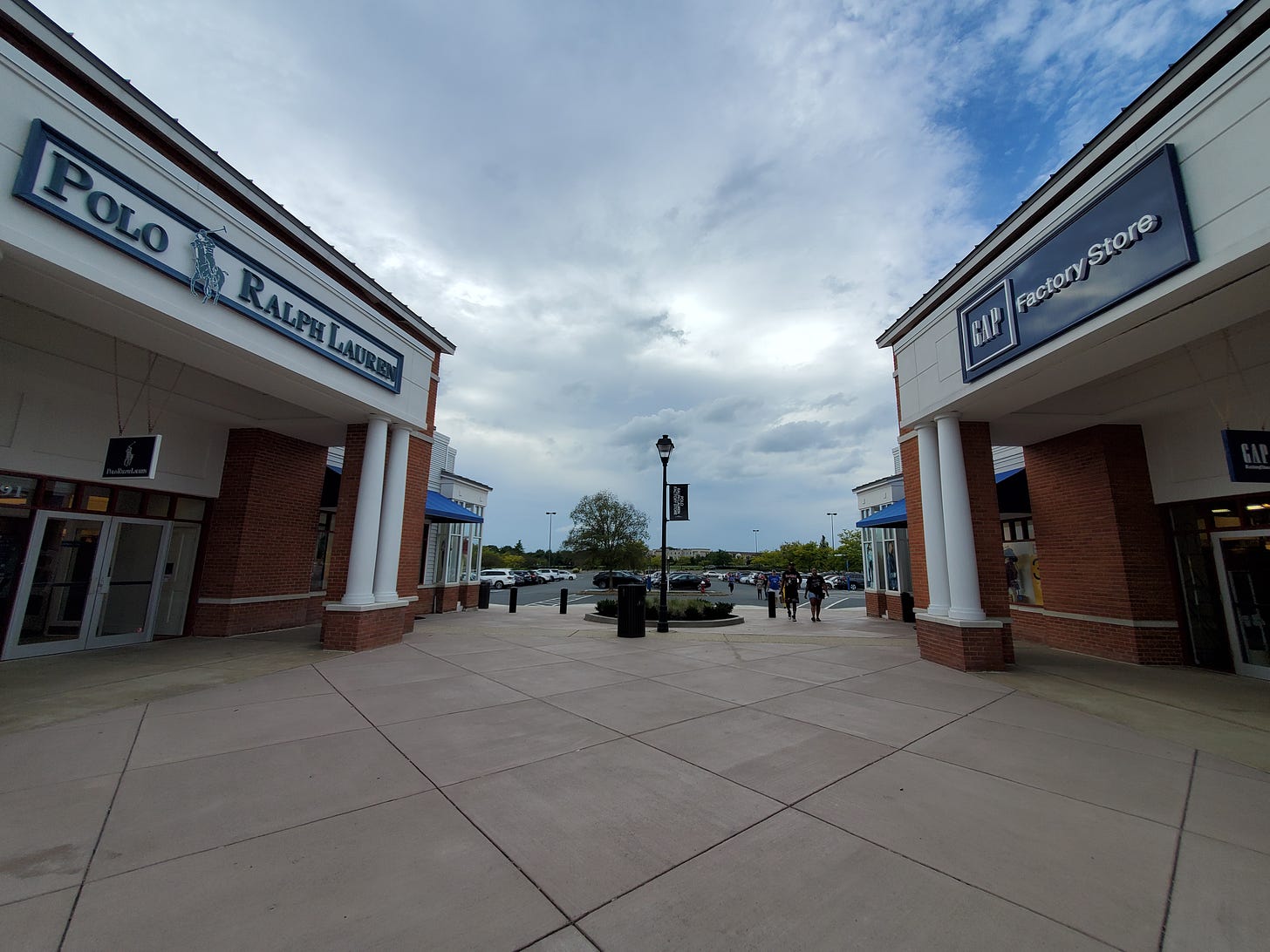I’m interested in towns and cities—and in things that try to look or feel like towns and cities. A couple of weeks ago I wrote about Reston Town Center, a development out in western Fairfax County, Virginia that features high-rise buildings and mixed uses (apartments, condos, offices, restaurants, stores, a hotel, a park/square.) It’s not a “real” city, but in some important ways it does feel like one. At the very least, it provides some of what people like about urban environments. And that can be important, especially out in the middle of the suburbs.
It got this really interesting pair of reactions:
That’s a great way of putting it. But the sense in which you really have walkability, or something truly urban, differs quite a bit from development to development. In that same piece I wrote of these things: “They’re an interesting combination of real downtowns and outdoor shopping malls. Some have more of that outdoor-mall or movie-set feel than others.”
It’s a fine line; the shopping mall itself was inspired by the layout of European urban streets, and it’s even car-free! But it is a shopping mall at the end of the day, and does’t really pretend to be anything else. So I’ve been particularly fascinated by places that are nothing but shopping malls—but which copy a surprising amount of design DNA from New Urbanist-style developments.
Like the Leesburg Premium Outlets.
Before I show you those, I’ll go back to my hometown of Flemington, New Jersey. Outlet malls have drawn on urban themes before, with colonial villages being a common theme in the 1970s and 1980s. The Liberty Village outlet center that used to drive Flemington’s economy was one of these. (I’ve photographed it and written about it.) It was laid out along brick paths, with low-rise brick buildings that looked like cottages or little village shops (or “shoppes”). Here’s a shot of Liberty Village:
There was a fountain, a clock, and a couple of cafes mixed in with the stores. Many people went there just to walk around. As with a conventional mall, there was an ocean of parking separate from the retail area, making the customer experience car-free, but very much not the overall property’s land use.
The Leesburg Premium Outlets are like that too. But they’re much, much larger and more modern. When you compare it with Liberty Village, it’s almost like you’re looking at an old and new generation of a product. The old one is in many ways obsolete, in terms of the scale at which these things pencil out, and the expectations of customers. Here is the new one:
What’s interesting to me about these new outlets, as suggested above, is how much has gone into the customer experience beyond shopping. There are fairly large public spaces (not truly public—there’s a long list of rules, and of course it’s private property), as well as spaces for kids. I would have welcomed that at Liberty Village; I have few memories of anything more stultifying than sitting on a perfunctory bench by the windows of the Maidenform or Ann Taylor store, waiting for my mother to finish shopping!
Here’s the “town square”:
There are the old-fashioned kiddie rides, which Liberty Village also had, as do and did many indoor malls:
But that’s just part of a whole playground area!
Aside from the urban-ish stuff, there’s also a fancy guest center:
Decorated with portraits of other outlet centers!
And here is the “edge”—where the walkable faux-city just ends and you’re back in the middle of utterly car-dependent exurban sprawl.
It kind of feels like you’re walking around a movie set, and every amenity is just in the service of getting you to stay longer and spend more. Yet it is a walkable, car-free place to stroll around.
I do wonder how many people first experience this kind of thing in a commercial setting like this, rather than in a real city? And if these faux-urban shopping centers are doing their little part in driving home that land use and urban design matter?
Related Reading:
Why Can’t Every Day Be Like a Christmas Market?
Thank you for reading! Please consider upgrading to a paid subscription to help support this newsletter. You’ll get a weekly subscribers-only post, plus full access to the archive: over 500 posts and growing. And you’ll help ensure more material like this!















So I lived in Flemington as a kid before moving to Belgium at age 6, and personally I have fairly rose-colored memories of Liberty Village. Most striking, though, is that I remember it being *lively*. Recently, I visited the new Leesberg Outlets, and the replacement just seems so ... dead? empty? I don't know. Probably I just went there at a not-very-busy time. Still, I felt it lacked something that Liberty Village had.
Anyway, glad and surprised to see someone writing about Flemington! :)
I'm writing to you from Canada, where I grew up in small-town suburbia not far from the American border. Though we now have outlet malls and strip malls abound, especially around larger city centres, the first time I ever encountered anything like this was on a trip to Myrtle Beach as a tween. I remember finding it so odd - why would you put a mall outside? It was also unbearably hot, being June in the South, which pushed shoppers into air-conditioned storefronts every 30 feet or so. I still find them such odd spaces...retail oases in a sea of parking. The whole experience is so commercial, so clearly artificially constructed to extract maximum attention and profit from shoppers...and yet so many people I know subject themselves to the experience, particularly on vacation. Always thought them strange and uncanny.